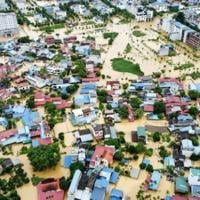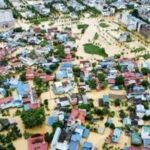Severe flooding, power outages, and destroyed infrastructure have impacted millions of people in Southeast Asia following the passage of Typhoon Yagi. The death toll has exceeded 200.
In Vietnam, the number of fatalities has reached 197, with eight confirmed deaths in northern Thailand. One district in Thailand is facing its worst floods in 80 years.
Typhoon Yagi made landfall in Vietnam over the weekend, causing widespread flooding in northern Vietnam, Laos, Thailand, and Myanmar. This catastrophic event has led to deadly landslides and significant river flooding.
A local farmer recounted how his peach blossom plantation, spanning 1,800 square meters, was completely submerged, resulting in the loss of all 400 trees. His estimated losses for the season amount to $40,000.
The devastating floods have destroyed over 250,000 hectares of crops and numerous livestock in Vietnam. Many communities are grappling with power cuts and thousands have been evacuated from their homes.
The tragedy has also struck mountainous Lao Cai province in Vietnam, where a landslide claimed seven lives and left 11 individuals missing. Another landslide wiped out an entire village, leaving at least 34 dead and 46 missing.
The Mekong River Commission has issued a flood warning for the historic Laotian city of Luang Prabang, a UNESCO World Heritage site. In Thailand, the death toll has risen to eight, with severe flooding reported in Mae Sai district on the border with Myanmar.
Relief efforts are underway in Thailand, with the government deploying helicopters to assess the situation and Buddhist temples opening their doors to shelter displaced individuals. Myanmar is also facing flooding, particularly near Naypyidaw, the capital city.
The impact of climate change on weather patterns is evident in the intensification of typhoons and prolonged heavy rains in Southeast Asia. A recent study highlighted how climate change contributes to the formation of typhoons closer to the coast, resulting in more devastating and prolonged impacts on land.





